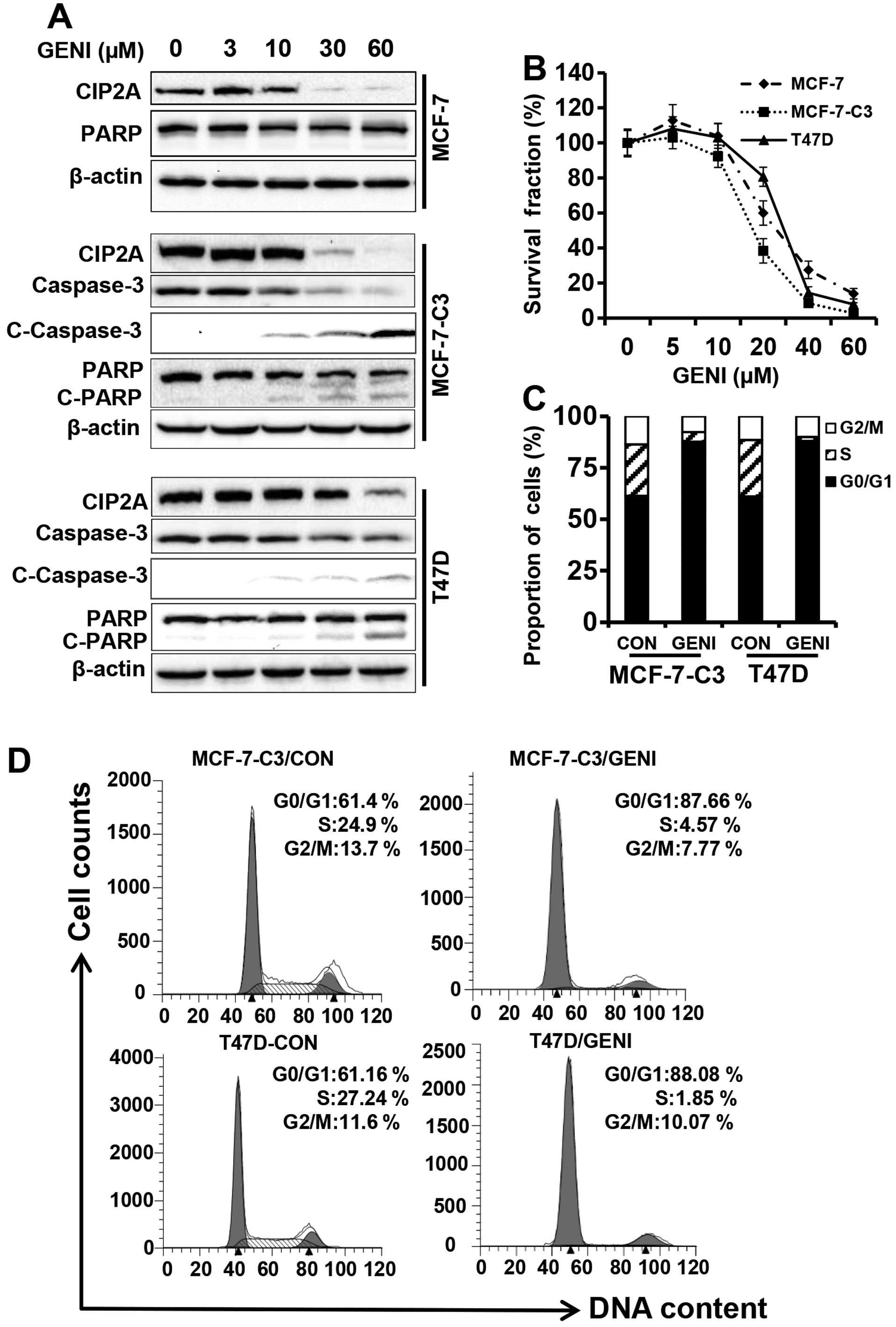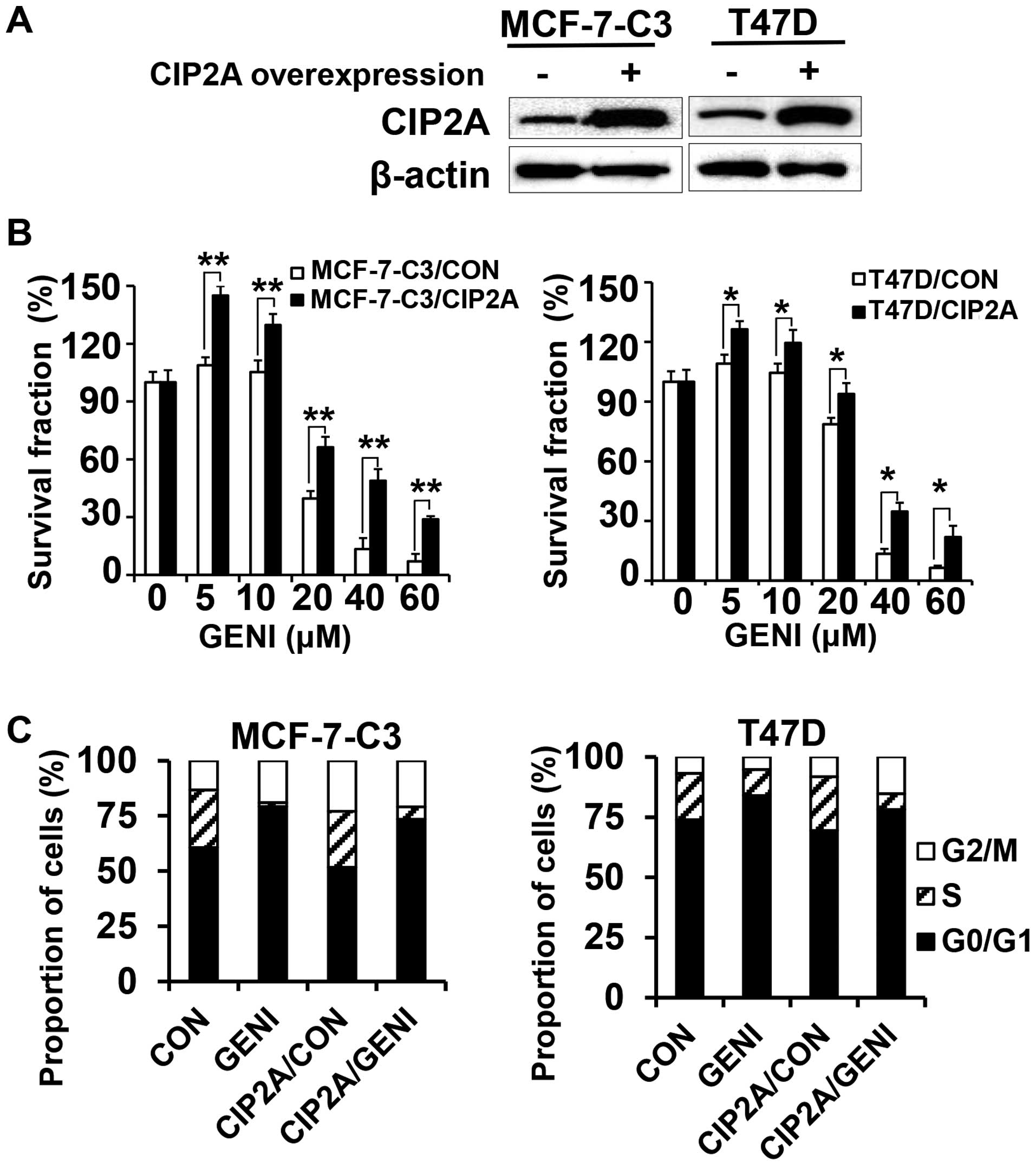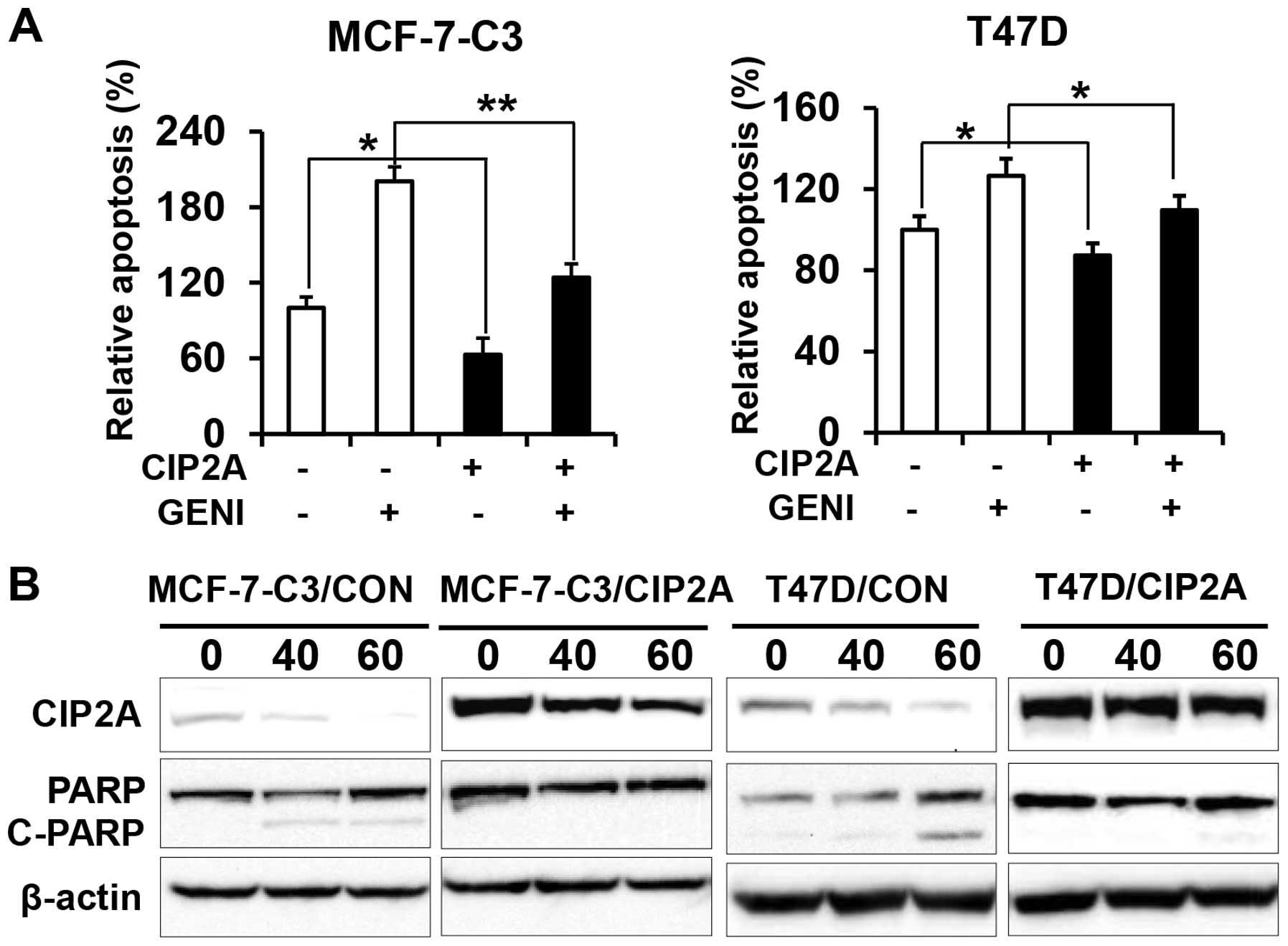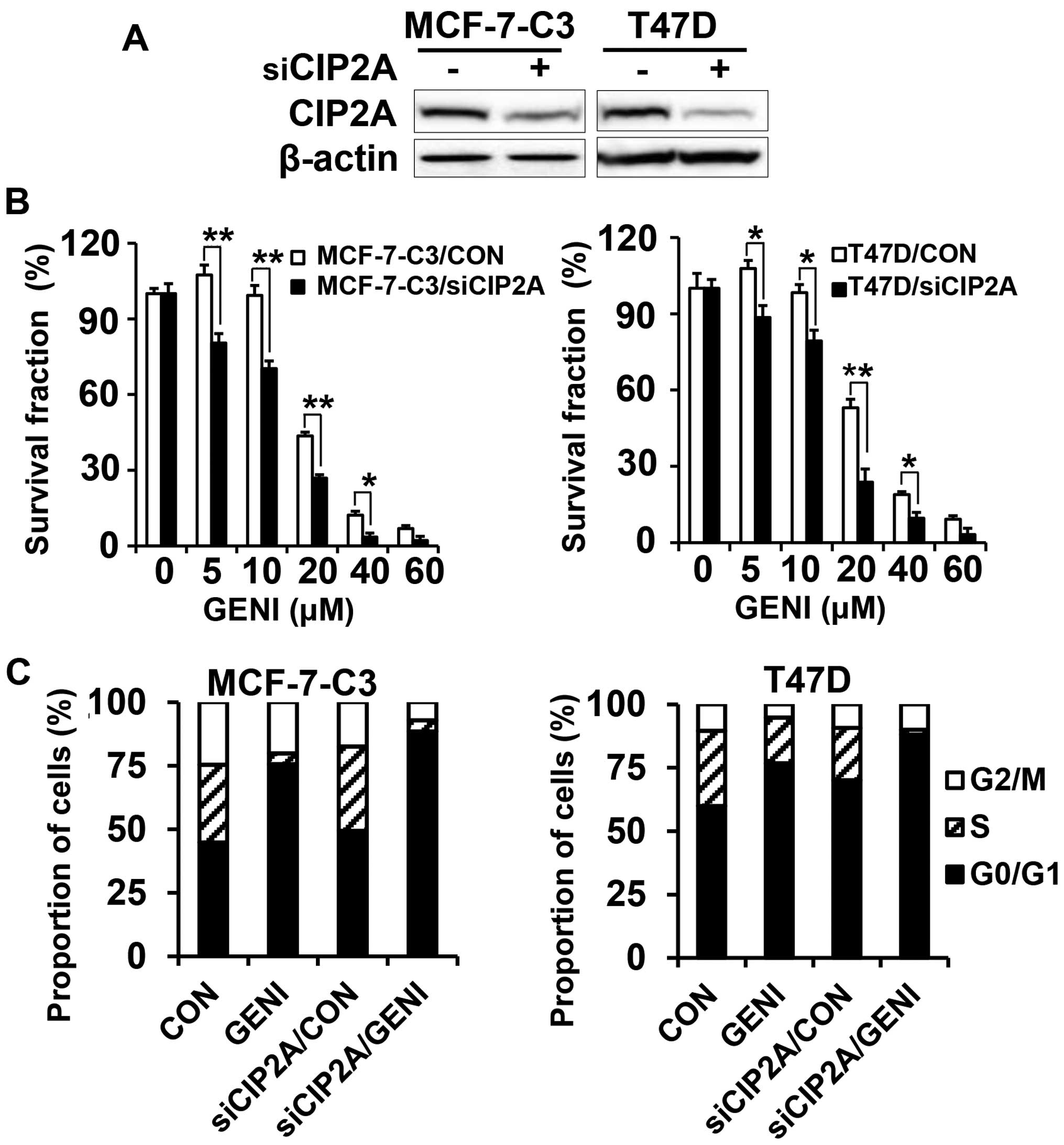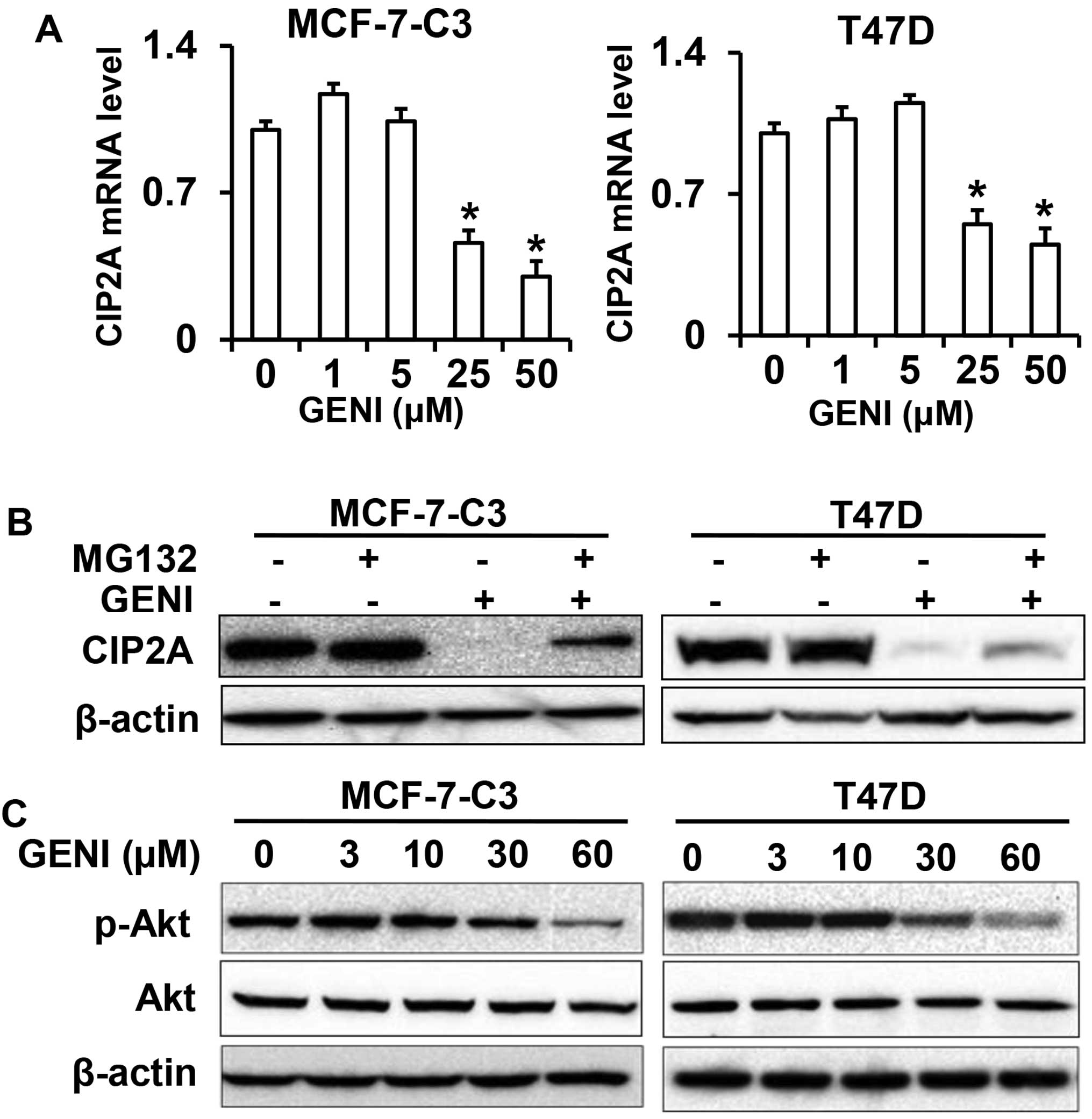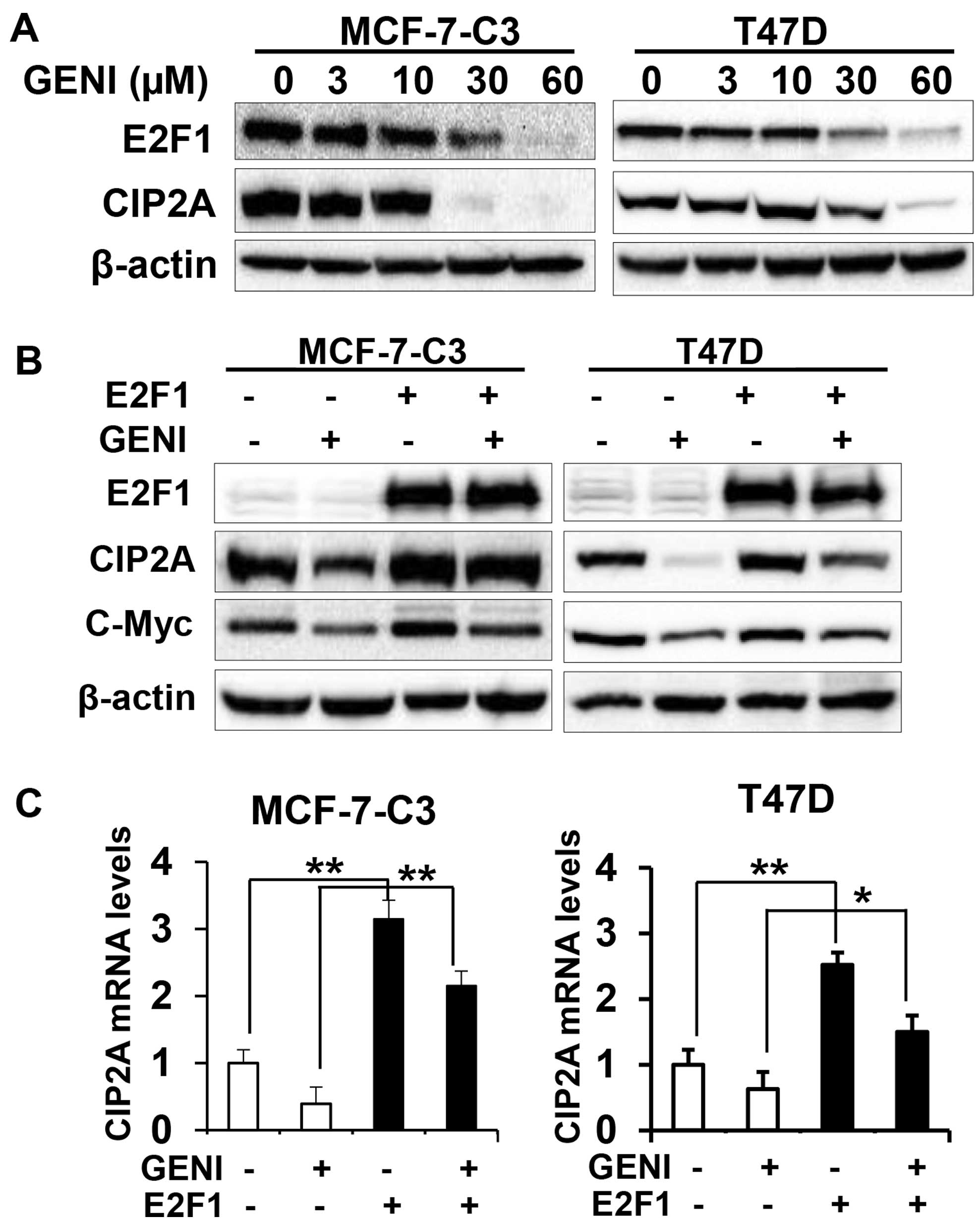|
1
|
Ferlay J1, Soerjomataram I, Dikshit R,
Eser S, Mathers C, Rebelo M, Parkin DM, Forman D and Bray F: Cancer
incidence and mortality worldwide: sources, methods and major
patterns in GLOBOCAN 2012. Int J Cancer. 136:E359–386. 2015.
View Article : Google Scholar
|
|
2
|
Bonofiglio D, Giordano C, De Amicis F,
Lanzino M and Ando S: Natural products as promising antitumoral
agents in breast cancer: Mechanisms of action and molecular
targets. Mini Rev Med Chem. 15:12015. View Article : Google Scholar
|
|
3
|
Nagata C, Mizoue T, Tanaka K, Tsuji I,
Tamakoshi A, Matsuo K, Wakai K, Inoue M, Tsugane S, Sasazuki S, et
al: Research Group for the Development and Evaluation of Cancer
Prevention Strategies in Japan: Soy intake and breast cancer risk:
An evaluation based on a systematic review of epidemiologic
evidence among the Japanese population. Jpn J Clin Oncol.
44:282–295. 2014. View Article : Google Scholar : PubMed/NCBI
|
|
4
|
Lamartiniere CA: Protection against breast
cancer with genistein: a component of soy. Am J Clin Nutr.
71:1705S–1707S; discussion 1708S–1709S. 2000.PubMed/NCBI
|
|
5
|
Shao ZM, Shen ZZ, Fontana JA and Barsky
SH: Genistein’s ‘ER-dependent and independent’ actions are mediated
through ER pathways in ER-positive breast carcinoma cell lines.
Anticancer Res. 20:2409–2416. 2000.PubMed/NCBI
|
|
6
|
Akiyama T, Ishida J, Nakagawa S, Ogawara
H, Watanabe S, Itoh N, Shibuya M and Fukami Y: Genistein, a
specific inhibitor of tyrosine-specific protein kinases. J Biol
Chem. 262:5592–5595. 1987.PubMed/NCBI
|
|
7
|
Corbett AH, Hong D and Osheroff N:
Exploiting mechanistic differences between drug classes to define
functional drug interaction domains on topoisomerase II. Evidence
that several diverse DNA cleavage-enhancing agents share a common
site of action on the enzyme. J Biol Chem. 268:14394–14398.
1993.PubMed/NCBI
|
|
8
|
Wang TT, Sathyamoorthy N and Phang JM:
Molecular effects of genistein on estrogen receptor mediated
pathways. Carcinogenesis. 17:271–275. 1996. View Article : Google Scholar : PubMed/NCBI
|
|
9
|
Sarkar FH and Li Y: Mechanisms of cancer
chemoprevention by soy isoflavone genistein. Cancer Metastasis Rev.
21:265–280. 2002. View Article : Google Scholar
|
|
10
|
Khanna A, Pimanda JE and Westermarck J:
Cancerous inhibitor of protein phosphatase 2A, an emerging human
oncoprotein and a potential cancer therapy target. Cancer Res.
73:6548–6553. 2013. View Article : Google Scholar : PubMed/NCBI
|
|
11
|
Côme C1, Laine A, Chanrion M, Edgren H,
Mattila E, Liu X, Jonkers J, Ivaska J, Isola J, Darbon JM, et al:
CIP2A is associated with human breast cancer aggressivity. Clin
Cancer Res. 15:5092–5100. 2009. View Article : Google Scholar : PubMed/NCBI
|
|
12
|
Junttila MR, Puustinen P, Niemelä M, Ahola
R, Arnold H, Böttzauw T, Ala-aho R, Nielsen C, Ivaska J, Taya Y, et
al: CIP2A inhibits PP2A in human malignancies. Cell. 130:51–62.
2007. View Article : Google Scholar : PubMed/NCBI
|
|
13
|
Khanna A, Böckelman C, Hemmes A, Junttila
MR, Wiksten JP, Lundin M, Junnila S, Murphy DJ, Evan GI, Haglund C,
et al: MYC-dependent regulation and prognostic role of CIP2A in
gastric cancer. J Natl Cancer Inst. 101:793–805. 2009. View Article : Google Scholar : PubMed/NCBI
|
|
14
|
Khanna A and Pimanda JE: Clinical
significance of cancerous inhibitor of protein phosphatase 2A in
human cancers. Int J Cancer. 138:525–532. 2016. View Article : Google Scholar
|
|
15
|
Yu G, Liu G, Dong J and Jin Y: Clinical
implications of CIP2A protein expression in breast cancer. Med
Oncol. 30:5242013. View Article : Google Scholar : PubMed/NCBI
|
|
16
|
Mumby M: PP2A: Unveiling a reluctant tumor
suppressor. Cell. 130:21–24. 2007. View Article : Google Scholar : PubMed/NCBI
|
|
17
|
Mathiasen DP, Egebjerg C, Andersen SH,
Rafn B, Puustinen P, Khanna A, Daugaard M, Valo E, Tuomela S,
Bøttzauw T, et al: Identification of a c-Jun N-terminal
kinase-2-dependent signal amplification cascade that regulates
c-Myc levels in ras transformation. Oncogene. 31:390–401. 2012.
View Article : Google Scholar
|
|
18
|
De P, Carlson J, Leyland-Jones B and Dey
N: Oncogenic nexus of cancerous inhibitor of protein phosphatase 2A
(CIP2A): An oncoprotein with many hands. Oncotarget. 5:4581–4602.
2014. View Article : Google Scholar : PubMed/NCBI
|
|
19
|
De P, Carlson JH, Leyland-Jones B and Dey
N: Role of ‘oncogenic nexus’ of CIP2A in breast oncogenesis: How
does it work? Am J Cancer Res. 5:2872–2891. 2015.
|
|
20
|
Chao TT, Wang CY, Lai CC, Chen YL, Tsai
YT, Chen PT, Lin HI, Huang YC, Shiau CW, Yu CJ, et al: TD-19, an
erlotinib derivative, induces epidermal growth factor receptor
wild-type nonsmall-cell lung cancer apoptosis through
CIP2A-mediated pathway. J Pharmacol Exp Ther. 351:352–358. 2014.
View Article : Google Scholar : PubMed/NCBI
|
|
21
|
Liu Z, Ma L, Wen ZS, Hu Z, Wu FQ, Li W,
Liu J and Zhou GB: Cancerous inhibitor of PP2A is targeted by
natural compound celastrol for degradation in non-small-cell lung
cancer. Carcinogenesis. 35:905–914. 2014. View Article : Google Scholar
|
|
22
|
Ding Y, Wang Y, Ju S, Wu X, Zhu W, Shi F
and Mao L: Role of CIP2A in the antitumor effect of bortezomib in
colon cancer. Mol Med Rep. 10:387–392. 2014.PubMed/NCBI
|
|
23
|
Yang XH, Edgerton S and Thor AD:
Reconstitution of caspase-3 sensitizes MCF-7 breast cancer cells to
radiation therapy. Int J Oncol. 26:1675–1680. 2005.PubMed/NCBI
|
|
24
|
Yang XH, Sladek TL, Liu X, Butler BR,
Froelich CJ and Thor AD: Reconstitution of caspase 3 sensitizes
MCF-7 breast cancer cells to doxorubicin- and etoposide-induced
apoptosis. Cancer Res. 61:348–354. 2001.PubMed/NCBI
|
|
25
|
Yang XH and Sladek TL: Overexpression of
the E2F-1 transcription factor gene mediates cell transformation.
Gene Expr. 4:195–204. 1995.PubMed/NCBI
|
|
26
|
Yang X, Yang S, McKimmey C, Liu B,
Edgerton SM, Bales W, Archer LT and Thor AD: Genistein induces
enhanced growth promotion in ER-positive/erbB-2-overexpressing
breast cancers by ER-erbB-2 cross talk and p27/kip1 downregulation.
Carcinogenesis. 31:695–702. 2010. View Article : Google Scholar : PubMed/NCBI
|
|
27
|
Jänicke RU, Sprengart ML, Wati MR and
Porter AG: Caspase-3 is required for DNA fragmentation and
morphological changes associated with apoptosis. J Biol Chem.
273:9357–9360. 1998. View Article : Google Scholar : PubMed/NCBI
|
|
28
|
Talanian RV, Yang X, Turbov J, Seth P,
Ghayur T, Casiano CA, Orth K and Froelich CJ: Granule-mediated
killing: Pathways for granzyme B-initiated apoptosis. J Exp Med.
186:1323–1331. 1997. View Article : Google Scholar : PubMed/NCBI
|
|
29
|
Yang S, Thor AD, Edgerton S and Yang X:
Caspase-3 mediated feedback activation of apical caspases in
doxorubicin and TNF-alpha induced apoptosis. Apoptosis.
11:1987–1997. 2006. View Article : Google Scholar : PubMed/NCBI
|
|
30
|
Zhang W, Chen H, Chen Y, Liu J, Wang X, Yu
X, Chen JJ and Zhao W: Cancerous inhibitor of protein phosphatase
2A contributes to human papillomavirus oncoprotein E7-induced cell
proliferation via E2F1. Oncotarget. 6:5253–5262. 2015. View Article : Google Scholar : PubMed/NCBI
|
|
31
|
Laine A, Sihto H, Come C, Rosenfeldt MT,
Zwolinska A, Niemelä M, Khanna A, Chan EK, Kähäri VM,
Kellokumpu-Lehtinen PL, et al: Senescence sensitivity of breast
cancer cells is defined by positive feedback loop between CIP2A and
E2F1. Cancer Discov. 3:182–197. 2013. View Article : Google Scholar : PubMed/NCBI
|
|
32
|
Constantinou AI, Kamath N and Murley JS:
Genistein inactivates bcl-2, delays the G2/M phase of the cell
cycle, and induces apoptosis of human breast adenocarcinoma MCF-7
cells. Eur J Cancer. 34:1927–1934. 1998. View Article : Google Scholar
|
|
33
|
Oki T, Sowa Y, Hirose T, Takagaki N,
Horinaka M, Nakanishi R, Yasuda C, Yoshida T, Kanazawa M, Satomi Y,
et al: Genistein induces Gadd45 gene and G2/M cell cycle arrest in
the DU145 human prostate cancer cell line. FEBS Lett. 577:55–59.
2004. View Article : Google Scholar : PubMed/NCBI
|
|
34
|
Yu JY, Lee JJ, Lim Y, Kim TJ, Jin YR,
Sheen YY and Yun YP: Genistein inhibits rat aortic smooth muscle
cell proliferation through the induction of p27kip1. J
Pharmacol Sci. 107:90–98. 2008. View Article : Google Scholar : PubMed/NCBI
|
|
35
|
Kuzumaki T, Kobayashi T and Ishikawa K:
Genistein induces p21Cip1/WAF1 expression and blocks the
G1 to S phase transition in mouse fibroblast and melanoma cells.
Biochem Biophys Res Commun. 251:291–295. 1998. View Article : Google Scholar : PubMed/NCBI
|
|
36
|
Shen JC, Klein RD, Wei Q, Guan Y, Contois
JH, Wang TT, Chang S and Hursting SD: Low-dose genistein induces
cyclin-dependent kinase inhibitors and G1 cell-cycle
arrest in human prostate cancer cells. Mol Carcinog. 29:92–102.
2000. View Article : Google Scholar : PubMed/NCBI
|
|
37
|
Yang S, Zhou Q and Yang X: Caspase-3
status is a determinant of the differential responses to genistein
between MDA-MB-231 and MCF-7 breast cancer cells. Biochim Biophys
Acta. 1773:903–911. 2007. View Article : Google Scholar : PubMed/NCBI
|
|
38
|
Guo Z, Liu D and Su Z: CIP2A mediates
prostate cancer progression via the c-MYC signaling pathway. Tumour
Biol. 36:3583–3589. 2015. View Article : Google Scholar : PubMed/NCBI
|
|
39
|
Kim JS, Kim EJ, Oh JS, Park IC and Hwang
SG: CIP2A modulates cell-cycle progression in human cancer cells by
regulating the stability and activity of Plk1. Cancer Res.
73:6667–6678. 2013. View Article : Google Scholar : PubMed/NCBI
|
|
40
|
Ventelä S, Côme C, Mäkelä JA, Hobbs RM,
Mannermaa L, Kallajoki M, Chan EK, Pandolfi PP, Toppari J and
Westermarck J: CIP2A promotes proliferation of spermatogonial
progenitor cells and spermatogenesis in mice. PLoS One.
7:e332092012. View Article : Google Scholar : PubMed/NCBI
|
|
41
|
Wang J, Huang T, Sun J, Yu Y, Liu Z, Li W,
Jia J and Chen C: CIP2A is overexpressed and involved in the
pathogenesis of chronic myelocytic leukemia by interacting with
breakpoint cluster region-Abelson leukemia virus. Med Oncol.
31:1122014. View Article : Google Scholar : PubMed/NCBI
|
|
42
|
Lei N, Peng B and Zhang JY: CIP2A
regulates cell proliferation via the AKT signaling pathway in human
lung cancer. Oncol Rep. 32:1689–1694. 2014.PubMed/NCBI
|
|
43
|
Niemelä M, Kauko O, Sihto H, Mpindi JP,
Nicorici D, Pernilä P, Kallioniemi OP, Joensuu H, Hautaniemi S and
Westermarck J: CIP2A signature reveals the MYC dependency of
CIP2A-regulated phenotypes and its clinical association with breast
cancer subtypes. Oncogene. 31:4266–4278. 2012. View Article : Google Scholar : PubMed/NCBI
|
|
44
|
Khanna A, Rane JK, Kivinummi KK, Urbanucci
A, Helenius MA, Tolonen TT, Saramäki OR, Latonen L, Manni V,
Pimanda JE, et al: CIP2A is a candidate therapeutic target in
clinically challenging prostate cancer cell populations.
Oncotarget. 6:19661–19670. 2015. View Article : Google Scholar : PubMed/NCBI
|
|
45
|
Gonzalez-Alonso P, Cristobal I, Manso R,
Madoz-Gurpide J, Garcia-Foncillas J and Rojo F: PP2A inhibition as
a novel therapeutic target in castration-resistant prostate cancer.
Tumour Biol. 36:5753–5755. 2015. View Article : Google Scholar : PubMed/NCBI
|
|
46
|
Kazi A, Daniel KG, Smith DM, Kumar NB and
Dou QP: Inhibition of the proteasome activity, a novel mechanism
associated with the tumor cell apoptosis-inducing ability of
genistein. Biochem Pharmacol. 66:965–976. 2003. View Article : Google Scholar : PubMed/NCBI
|
|
47
|
Mundle SD and Saberwal G: Evolving
intricacies and implications of E2F1 regulation. FASEB J.
17:569–574. 2003. View Article : Google Scholar : PubMed/NCBI
|
|
48
|
Moon NS, Frolov MV, Kwon EJ, Di Stefano L,
Dimova DK, Morris EJ, Taylor-Harding B, White K and Dyson NJ:
Drosophila E2F1 has context-specific pro- and antiapoptotic
properties during development. Dev Cell. 9:463–475. 2005.
View Article : Google Scholar : PubMed/NCBI
|
|
49
|
Laine A and Westermarck J: Molecular
pathways: harnessing E2F1 regulation for prosenescence therapy in
p53-defective cancer cells. Clin Cancer Res. 20:3644–3650. 2014.
View Article : Google Scholar : PubMed/NCBI
|
|
50
|
Choi YA, Koo JS, Park JS, Park MY, Jeong
AL, Oh KS and Yang Y: Estradiol enhances CIP2A expression by the
activation of p70 S6 kinase. Endocr Relat Cancer. 21:189–202. 2014.
View Article : Google Scholar
|
|
51
|
Xue Y, Wu G, Wang X, Zou X, Zhang G, Xiao
R, Yuan Y, Long D, Yang J, Wu Y, et al: CIP2A is a predictor of
survival and a novel therapeutic target in bladder urothelial cell
carcinoma. Med Oncol. 30:4062013. View Article : Google Scholar : PubMed/NCBI
|



